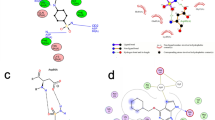Abstract
Steered molecular dynamics (SMD) was used to identify the interacting amino-acid residues on the surfaces of formin mDia1 domains for DID–DAD interactions, which is responsible for formin autoinhibition, and DID–Rho GTPase, which is responsible for formin activation. Ionic interactions between Glu178 and Arg248 and hydrophobic interactions between a carbon atom of Thr175 and the aromatic ring of Phe247 were the most stable. The DID–Rho interaction was the strongest, being mediated by triple ionic interactions of positively charged Rho residues with a DID amino-acid triplet, which included two negatively charged residues with an uncharged one between them. The DID sites binding with Rho and DAD overlap in part, but different DID amino-acid residues are involved in DID interactions with different partners. Conformational changes potentially arising in the formin domains upon activation or inactivation are discussed.
Similar content being viewed by others
Abbreviations
- Rho:
-
Rho GTPase
- MD:
-
molecular dynamics
- SMD:
-
steered molecular dynamics
References
Yu. N. Vasil’ev, Soros. Obraz. Zh. 2, 36 (1996).
S. H. Lee and R. Dominguez, Mol. Cells 29, 311 (2010).
S. Maiti, A. Michelot, C. Gould, et al., Cytoskeleton (Hoboken) 69, 393 (2012).
T. Otomo, D. R. Tomchick, C. Otomo, et al., PLOS ONE 5 (9), el2896 (2010).
A. G. Nezami, Poy F., and M. J. Eck, Structure 14, 257 (2006).
J. B. Moseley, I. Sagot, A. L. Manning, et al., Mol. Biol. Cell 15, 896 (2004).
M. Lammers, R. Rose, A. Scrima, and A. Wittinghofer, EMBO J. 24, 4176 (2005).
F. Li and H. N. Higgs, J. Biol. Chem. 280, 6986 (2005).
T. Otomo, D. R. Tomchick, C. Otomo, et al., Nature 433, 488 (2005).
R. Rose, M. Weyand, M. Lammers, et al., Nature 435, 513 (2005).
D. Pruyne, M. Evangelista, C. Yang, et al., Science 297, 612 (2002).
A. Seth, C. Otomo, and M. K. Rosen, J. Cell Biol. 174, 701 (2006).
M. Chesarone, C. J. Gould, J. B. Moseley, and B. L. Goode, Dev. Cell 16, 292 (2009).
S. B. Padrick and M. K. Rosen, Annu. Rev. Biochem. 79, 707 (2010).
Author information
Authors and Affiliations
Corresponding author
Additional information
Original Russian Text © I.A. Orshanskiy, A.V. Popinako, A.D. Koromyslova, O.I. Volokh, K.V. Shaitan, O.S Sokolov, 2015, published in Biofizika, 2015, Vol. 60, No. 3, pp. 451–456.
Rights and permissions
About this article
Cite this article
Orshanskiy, I.A., Popinako, A.V., Koromyslova, A.D. et al. The molecular dynamics of N- and C-terminal interactions during autoinhibition and activation of formin mDial. BIOPHYSICS 60, 361–364 (2015). https://doi.org/10.1134/S0006350915030136
Received:
Published:
Issue Date:
DOI: https://doi.org/10.1134/S0006350915030136




